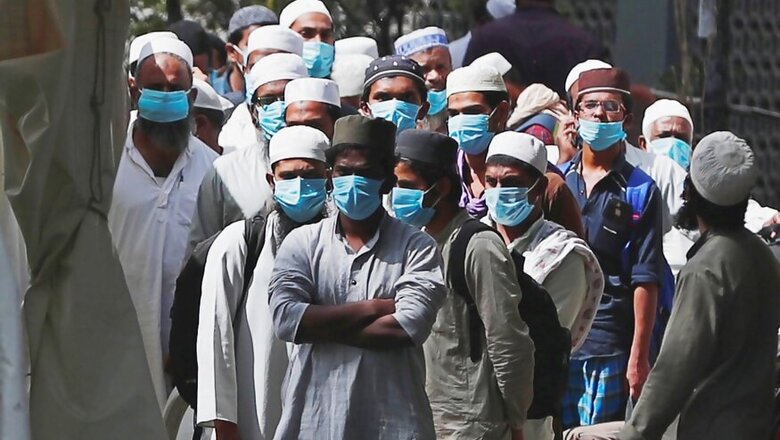
views
New Delhi: India’s government is blaming an Islamic missionary meeting for a surge in coronavirus cases, triggering a wave of violence, business boycotts and hate speech toward Muslims that experts warn could worsen the pandemic in the world’s second-most populous country.
The stigma faced by India’s Muslims, poorer and with less access to health care than other groups, is making health workers’ battle against the virus even tougher, according to veterans of other epidemics. India has about 24,500 confirmed coronavirus cases — about one in five of which have been linked to the missionary meeting — and 775 deaths, and the outbreak may not peak until June.
“Not only is the (Muslim) community at a higher risk of being infected, but they will also be at a high risk of spreading the virus,” said Dr Anant Bhan, a bioethics and global health expert. “It becomes a cycle that will continue.”
About 8,000 people in the Tablighi Jamaat congregation met for three days in March at the group’s compound in the crowded Nizamuddin area of New Delhi, shortly before the Indian government banned large gatherings. The compound stayed open, later giving shelter to people stranded in a 21-day lockdown imposed by Prime Minister Narendra Modi on March 24, according to the group’s spokesman, Mujeeb ur Rehman.
On the second day of the lockdown, a government raid on the compound discovered the largest virus cluster in India. Police filed a case against some of the group’s leaders for violating the ban, a charge the group denies. Officials said Tuesday they have arrested 29 people, including 16 foreigners, who participated in the missionary meeting.
India’s communal fault lines, still stressed by deadly riots over a new naturalization law that excludes Muslims, were split wide open by the allegations against Jamaat.
Politicians in Bharatiya Janata Party were quoted on TV and in newspapers describing the Jamaat incident as “corona terrorism.”
False news targeting Muslims began to circulate, including video clips purportedly showing congregation members spitting on authorities. The clips were quickly proven to be fake, yet by April 1, the hashtag
“CoronaJihad” was trending on Twitter in India.
Lav Aggarwal, joint secretary of India’s health ministry, repeatedly called out the congregation by name in daily news briefings. On April 5, he said the number of virus cases was doubling in just 4.1 days, and would have been a slower 7.4 days “if the additional ... cases due to the Tablighi Jamaat meeting would not have arisen.”
That same day, Dilshad Mohammad took his life.
Panic, blame and stigma were spreading across India when the 37-year-old chicken peddler was shunned by his neighbors in Bangarh, a village in the hilly state of Himachal Pradesh, for giving two members of the Jamaat congregation a ride to their village on his scooter. Neighbors accused him of deliberately trying to infect them with the virus, which causes the Covid-19. Karthikeyan Gokulachandran, the district police superintendent, blamed his suicide on stigma.
In Rajasthan state, a pregnant Muslim woman was turned away from a public hospital because of her religion, resulting in the death of her 7-month-old fetus, said Vishvendra Singh, the state’s tourism minister.In Uttarakhand, Hindu youths forced Muslim fruit vendors to stop selling. Shots were fired at a mosque in Gurugram, a suburb of New Delhi, and a Muslim family in the neighboring state of Haryana was attacked by neighbors who accused them of not turning off their lights on April 9, the night Modi had asked the country to extinguish household lights for 15 minutes in a show of national unity.
Doctors who studied previous epidemics warn that stigma and blame for a contagious disease weaken trust in marginalized communities, threatening decades-long efforts against illnesses such as polio and tuberculosis by making people less likely to seek treatment.
Stigma in general is adding to India’s coronavirus death toll, said Dr. Randeep Guleria, head of the All India Institute of Medical Sciences in Delhi and among the architects of the country’s response.
“It is actually causing increasing morbidity and mortality. Because of the stigma that is happening, many patients who have COVID-19 or who have flu-like symptoms are not coming forward,” he said.
Muslims were already at a disadvantage when the coronavirus entered India.
India’s 200 million Muslims account for 14% of the population and are the largest minority group in the Hindu-majority nation and also the poorest, surviving on an average of 32.6 rupees ($0.43) per day, a 2013 government survey found.
Muslims also have less access to health care. About 40% of villages with large Muslims populations don’t have medical facilities, a government report in 2006 said. The government in Maharahstra – the state with the biggest concentration of coronavirus cases – said Muslim-majority areas had a “paucity of health facilities” in a 2013 report. It said the “threat of communal riots” forced Muslims to “live together in slums and ghettos” where social distancing is often impossible.
In deeply polarized India, some Modi critics have suggested that the government singled out the Jamaat congregation for strategic reasons.
The “vilification of Muslims was done to hide the government’s mismanagement in dealing with the virus and their callousness,” said Professor Tanweer Fazal, a sociologist at the University of Hyderabad.
Aggarwal, the health ministry spokesman, declined to respond.
On Sunday, Modi tweeted that the coronavirus does not discriminate based on race, religion or creed.
“Our response and conduct thereafter should attach primacy to unity and brotherhood. We are in this together,” he said.
His remarks came hours after the Organization of Islamic Cooperation’s human rights body condemned the “unrelenting vicious Islamophobic campaign in India maligning Muslims for spread of Covid-19.”



















Comments
0 comment